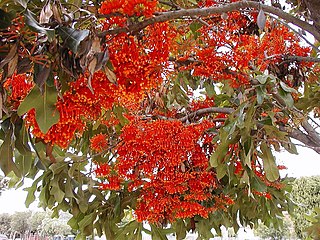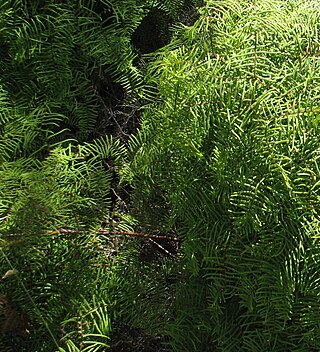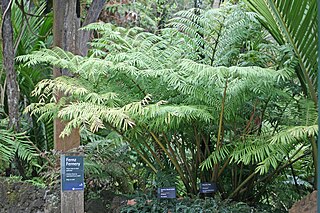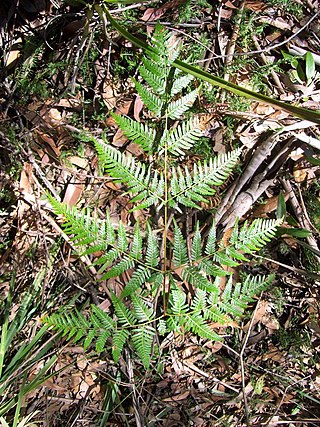
The ferns are a group of vascular plants that reproduce via spores and have neither seeds nor flowers. They differ from mosses by being vascular, i.e., having specialized tissues that conduct water and nutrients, and in having life cycles in which the branched sporophyte is the dominant phase.

Araucaria is a genus of evergreen coniferous trees in the family Araucariaceae. While today they are largely confined to the Southern Hemisphere, during the Jurassic and Cretaceous they were globally distributed. There are 20 extant species in New Caledonia, Norfolk Island, eastern Australia, New Guinea, Argentina, Brazil, Chile and Uruguay.

Osmunda is a genus of primarily temperate-zone ferns of family Osmundaceae. Five to ten species have been listed for this genus.

Psilotaceae is a family of ferns consisting of two genera, Psilotum and Tmesipteris with about a dozen species. It is the only family in the order Psilotales.

Myoporum is a genus of flowering plants in the figwort family, Scrophulariaceae. There are 30 species in the genus, eighteen of which are endemic to Australia although others are endemic to Pacific Islands, including New Zealand, and one is endemic to two Indian Ocean islands. They are shrubs or small trees with leaves that are arranged alternately and have white, occasionally pink flowers and a fruit that is a drupe.

Montrouziera is a genus of shrubs to large trees in the family Clusiaceae, endemic to New Caledonia. As usual in the Clusiaceae, species of this genus are known to contain xanthonoids. Montrouziera is related to the South American genus Platonia. Locally known as "houp", this genus was named after Xavier Montrouzier.

Pellaea is a genus of ferns in the Cheilanthoideae subfamily of the Pteridaceae. The genus name is derived from the Greek word πελλος (pellos), meaning "dark," and refers to the brown stems. Many members of the genus are commonly known as cliffbrakes. They primarily grow in rocky habitats, including moist rocky canyons, slopes, and bluffs.

Dennstaedtiaceae is one of fifteen families in the order Polypodiales, the most derived families within monilophytes (ferns). It comprises 10 genera with ca 240 known species, including one of the world's most abundant ferns, Pteridium aquilinum (bracken). Members of the order generally have large, highly divided leaves and have either small, round intramarginal sori with cup-shaped indusia or linear marginal sori with a false indusium formed from the reflexed leaf margin. The morphological diversity among members of the order has confused past taxonomy, but recent molecular studies have supported the monophyly of the order and the family. The reclassification of Dennstaedtiaceae and the rest of the monilophytes was published in 2006, so most of the available literature is not updated.

Schefflera is a genus of flowering plants in the family Araliaceae with 13 species native to New Zealand and some Pacific islands.

Stenocarpus is a genus of about 22 species of flowering plants in the family Proteaceae. They are trees or shrubs with variably-shaped leaves, zygomorphic, bisexual flowers, the floral tube opening on the lower side before separating into four parts, followed by fruit that is usually a narrow oblong or cylindrical follicle.
Canacomyrica is a monotypic genus of flowering plants in the family Myricaceae containing the single species Canacomyrica monticola. It is endemic to New Caledonia. This endangered tree or small shrub is limited to ultramafic serpentine soils.

The fern genus Todea is known from only two living species. Species in the genus Todea, as Leptopteris, are distinct from other in Osmundaceae in that sporangia are born on laminar pinnules.

Oncotheca is a genus of tree endemic to New Caledonia. There are two species, Oncotheca balansae and Oncotheca humboldtiana.

Gleichenia is a genus of ferns. Its closest relative is the genus Stromatopteris, restricted to New Caledonia.

Corynocarpus is the only genus of plants in the family Corynocarpaceae and includes five species. It is native to New Guinea, Australia, New Zealand, New Caledonia, and Vanuatu.

Ptisana is a genus in the eusporangiate fern family Marattiaceae, comprising species historically treated in the genus Marattia. The establishment of this genus follows the 2008 work by Andrew G. Murdock, which supported recognition of this group on the basis of genetic analysis and morphology. Ptisana can be distinguished from Marattia by the presence of distinct sutures at the point of leaflet attachment, deeply cut synangia, and the absence of labiate sporangial apertures. The name Ptisana is derived from the Latin word for pearl barley, an allusion to the shape of the synangia.

Pteridium esculentum, commonly known as bracken fern, Austral bracken or simply bracken, is a species of the bracken genus native to a number of countries in the Southern Hemisphere. Esculentum means edible. First described as Pteris esculenta by German botanist Georg Forster in 1786, it gained its current binomial name in 1908. The Eora people of the Sydney region knew it as gurgi.

Gleichenia dicarpa, commonly known as pouched coral fern or tangle fern, is a small fern of the family Gleicheniaceae found in eastern Australia, New Caledonia and New Zealand. It forms tangled thickets in wet places such as swamps and riverbanks.

Paesia is a genus of large, coarse ferns in the family Dennstaedtiaceae described as a genus in 1833. Species are known from South America, Central America, East Asia, and New Caledonia.
- Paesia acclivis(Kunze) Kuhn - Venezuela, Colombia, Ecuador, Peru
- Paesia amazonica(Christ) C. Chr. - Loreto Region in Peru
- Paesia anfractuosa(Christ) C. Chr. - Panama, Costa Rica
- Paesia glandulosa(Sw.) Kuhn - Panama, Costa Rica, Venezuela, Colombia, Ecuador, Peru, Bolivia
- Paesia rugulosa(Labill.) Kuhn - Vietnam, New Caledonia
- Paesia scalaris(Mett.) Kuhn
- Paesia taiwanensisW.C. Shieh - Taiwan

















